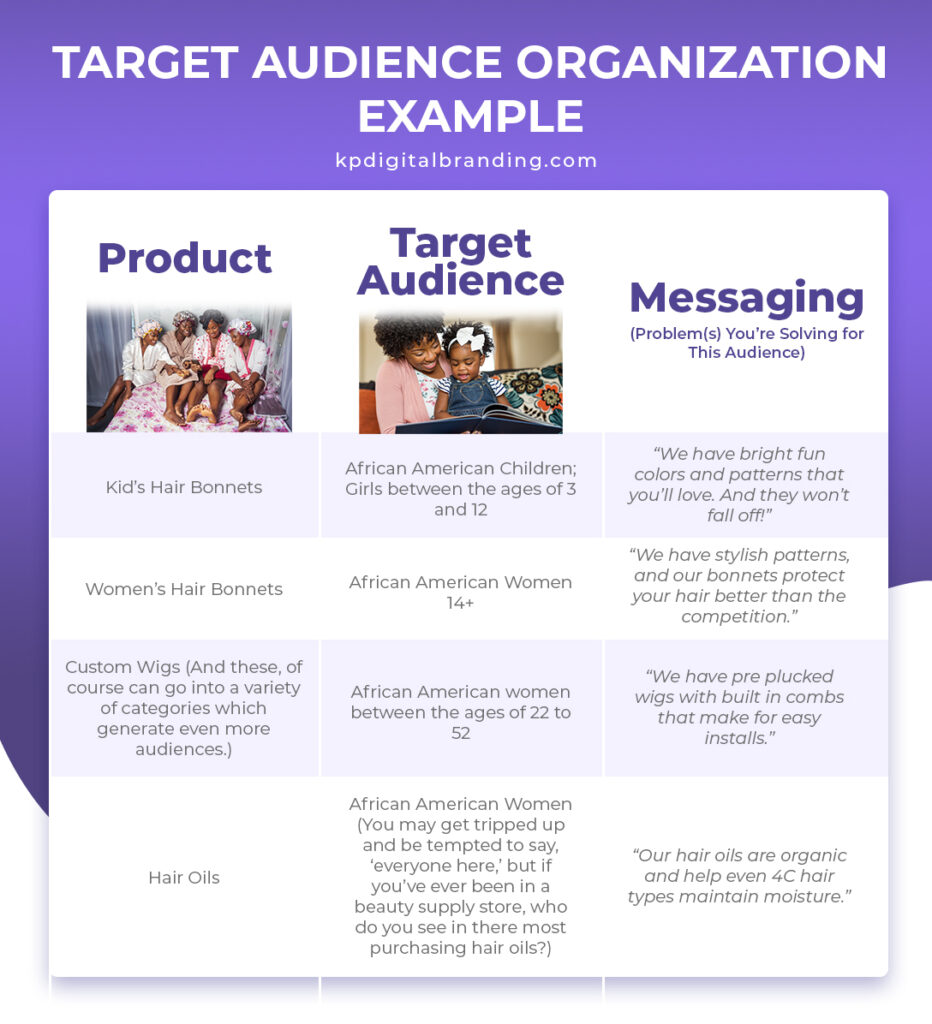When building a brand, finding your target audience (not to be confused with your target market) is one of the most important steps you’ll ever have to take. If in your mind, you think that your audience should be everyone, I will always be here to remind you that you can’t be everything to everybody. ?
Having a broad target audience will guarantee a lot of wasted money and resources marketing to the wrong person. Remember that you can always expand and broaden your audience later. If you’re just starting out, pick a niche and cater to it.
Think about how you felt when you read a message that really spoke to you. The advertiser may have struck a nerve and spoke to a problem that you thought only you had. The brand responsible for that message was most likely very deliberate about finding who their specific audience was, and guess what? You fit the bill.
Finding a target audience is an art and a science, and when done properly up front, you will be laying the foundation for a quicker path to profit and growth.
Master the art of target audience building with these 3 clear steps.
1. Define your Target Audience Before You Do Anything Else to Start Your Business
Very early on in my career as a parenting and lifestyle blogger I made the mistake of not defining an audience up front. I blogged about any and everything related to parenting. I focused on every age group and never clearly defined who it was I was talking to.
I had blog posts that would focus on parents of teens, and then my next post would be a write-up on the best diaper brands. I was everywhere and nowhere all at the same time.
It wasn’t until I wrote a post about natural hair care for kids that I found an audience who came and listened. Young African American moms totally got my cultural jokes and sassy brand of humor. I was solving their problem of finding ways to grow and care for their child’s natural hair and doing it in a way that they could relate to.
I soon watched my Instagram followers grow from a few hundred to well over 20,000 and had a successful career in the kid’s natural hair niche (a then untapped market) for many years.
Your number one job as a Bomb A$$ Brander and entrepreneur is to solve a problem that a very specific type of person has. You can’t do that without understanding and building a relationship with people who want to do business with you.
2. Remember: A Targeted Audience Produces Perfect Messaging
Okay friend – let’s pull out a pen and some paper and start mapping things out. Answer the following questions:
What’s the average age of your ideal customer?
Are they your age or a little older?
Keep in mind that you could have more than one age group to gear things toward. Say you sell custom hair accessories for kids. Your mom’s average age would need to be noted along with the average age of the child who would wear your accessories.
What problems does your ideal customer have that you can solve?
In our hair accessory example, your moms may want their little ones to rock a matching hair doodad with their outfit from time to time, and they want it to be safe and gentle on their little lady’s precious locks. But unfortunately, they’re independent little diva doesn’t like the selections that are out there. Your trendy, hair safe bows may solve the problems of both the mom and the child.
Let’s keep going.
Where are some of places that your ideal customer likes to shop? Justice? Claire’s?
What’s your ideal customer’s income?
Is your ideal customer well-off, or are they on a tight budget? If you make custom bows with rather expensive materials, then you’ll want to note that your target audience’s income should be on the higher end.
Once you have some of these basic demographics down, you should then be able to create online messaging that speaks directly to your ideal audience:
“Is Ms. Thang complaining about having to wear another plain school bow with her new outfit? Our diva bows are handmade with unique trendy materials like bright-colored leather and hair-safe satin.”
Targeted online messaging like that will make your clients or customers feel like you’re speaking directly to them. This is called personalized marketing, and it can’t be achieved until you’ve gotten to know your target audience on an intimate level.
3. Once You’ve Identified Your Target Audience, Now It’s Time to Get Organized
Target audience organization is necessary if you serve more than one group. And how do you know if you have more than one group? You have more than one group if you offer more than one product.
Say for instance you sell custom hair bonnets – your audience will, most likely, be one specific group. But if you have a variety of products, and say you sell hair bonnets, custom wigs, and hair oil, things may get a bit more complicated.
Here’s a breakdown:
(It should be noted that the following isn’t backed by research. This is purely for illustrative purposes.)

This may start to get a little tedious but push through. This is a necessary step that needs to be taken to get a handle on the type of messaging that you’ll need to work on creating. You may target a particular group during a specific time of year, or you could make it an annual cycle where you focus on one particular group at a time. The choice is yours.
Having your target groups mapped out can help with everything from cross-selling to deciding on the colors and shapes you’ll use for branding. Don’t skip it!
The one thing to avoid here is doing a whole lot of guessing. If you’re first starting out, you need to make sure that there is a need for whatever it is you’re offering. (Because, unfortunately, friend, just because you think it’s a great idea doesn’t mean that anyone has actually asked for it.)
You can feel confident that there’s a need for your product or service if you’ve already had a few customers. And even if you haven’t had any customers yet, if you have people asking you when you can provide them with what you’re offering, you’re good to go.
If you’ve had customers, you have the perfect group of people to get some of your target information from. This is called market research, and it’s an essential part of building and sustaining a brand.
Ask your customers about what pain points your product or service solves. Did it help them save money? Did it allow them to feel good or look good? Start mapping these things out alongside the target group breakdown you did earlier. You’ll begin building out a robust audience map that will be at the foundation of a highly effective marketing strategy.

